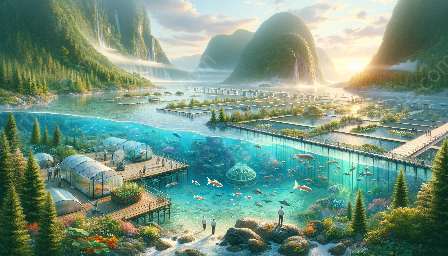Aquaculture, or fish farming, is an important industry that provides a significant portion of the world's seafood supply. However, the environmental impacts of aquaculture can be far-reaching and complex. In this topic cluster, we will explore the various ways in which aquaculture affects the environment, its relationship with fisheries science and applied sciences, and the potential solutions to mitigate these impacts.
Overview of Aquaculture
Aquaculture involves the farming of aquatic organisms, such as fish, shellfish, and plants, in controlled environments. It has become a critical source of food and income for many communities worldwide. However, the rapid expansion of aquaculture has raised concerns about its environmental consequences.
Impact on Water Quality
One of the most significant environmental impacts of aquaculture is its effect on water quality. The discharge of excess nutrients, antibiotics, and other chemicals used in fish farming can lead to eutrophication, algal blooms, and oxygen depletion in aquatic ecosystems. These changes can disrupt the balance of the ecosystem, affecting the survival of native species and overall water quality.
Loss of Biodiversity
Aquaculture operations can also lead to the loss of biodiversity in natural habitats. Escapes of farmed fish and the introduction of non-native species can outcompete and displace local species, leading to a decrease in overall biodiversity. This can have cascading effects on the entire ecosystem and compromise its resilience.
Impact on Coastal Ecosystems
The location of many aquaculture facilities in coastal regions can result in the degradation of coastal ecosystems. Habitat destruction, shoreline erosion, and pollution from fish waste and feed can impact the health of mangroves, seagrasses, and coral reefs, which are vital for the protection of coastlines and marine life.
Relationship with Fisheries Science
The environmental impacts of aquaculture are closely linked to fisheries science, as both disciplines share a common focus on the sustainable management of aquatic resources. Understanding the interactions between aquaculture and wild fish populations, the development of best practices, and the implementation of effective monitoring and management strategies are essential aspects of fisheries science in the context of aquaculture.
Applied Sciences Solutions
Addressing the environmental impacts of aquaculture requires the application of various scientific disciplines, including aquaculture and fisheries science. Innovative solutions such as integrated multi-trophic aquaculture (IMTA), which combines the farming of different species to utilize waste and reduce environmental impacts, and the development of sustainable aquafeeds using alternative ingredients are examples of how applied sciences can contribute to mitigating the environmental footprint of aquaculture.
Mitigation Strategies
Efforts to mitigate the environmental impacts of aquaculture include improved waste management, the development of environmentally friendly aquaculture practices, and the use of technology to minimize negative effects on the environment. Collaborative research, stakeholder engagement, and policy interventions are also crucial for promoting sustainable aquaculture and minimizing its environmental footprint.
Conclusion
Understanding the environmental impacts of aquaculture and its relationship with fisheries science and applied sciences is crucial for ensuring the sustainable development of this industry. By addressing the challenges and seeking innovative solutions, aquaculture can contribute to global food security while minimizing its environmental footprint and preserving the health and integrity of aquatic ecosystems.

